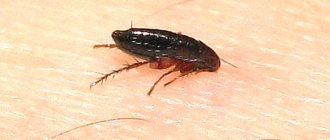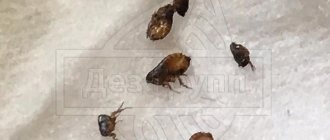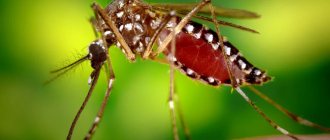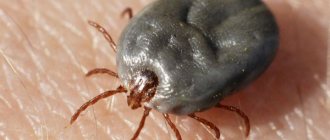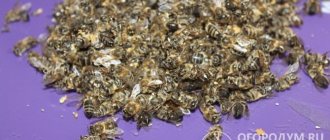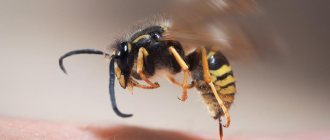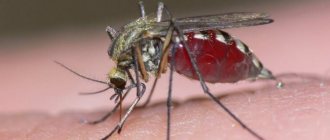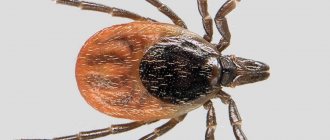How long a tick lives depends directly on climatic conditions and habitat. The genetic abilities of arachnids are impressive, but in real life the time frame is much shorter. About 50 thousand species of ticks are described in the scientific literature. People often use this word to mean ixodid ticks, which live in forests, groves, tall grass, and city parks. They feed on blood, attack animals, birds, and less often people.
How ticks live and bite
Ixodid ticks are specialized blood-sucking parasites of animals and humans, the largest representatives of the genus. In the warm season - from early spring to early autumn - it is they who begin the “hunt”.
Ticks are active and bite people and animals from spring to autumn
Many are convinced that ticks can only be found in forests, but this is not true. The parasite can be introduced into the urban environment with flowers, brushwood, and domestic animals (for example, dogs or cattle). There are known and not isolated cases of tick attacks in public gardens and parks. Ticks inhabit animal habitats, pastures, paddocks and wait for victims there. It is preferable for the parasite to hunt in bushes, grass and other low vegetation - this way it can easily and, most importantly, quickly climb onto the victim at the first favorable opportunity.
Having settled in ambush, the tick waits for the victim for quite a long time: in the spring, after winter hibernation, it begins to hunt; if there is no prey during the warm period, with the onset of cold weather it again goes “for the winter” until spring, after which it “wakes up” and continues to hunt.
A hungry tick can spend whole days, weeks and months waiting for a victim, falling into suspended animation during the winter.
Thanks to its well-developed sense of smell, it detects the approach of a potential host at a distance of up to 10 meters by earth vibrations, heat and smell. Having sensed “prey”, the tick, like antennae, extends its forelimbs forward in order to accurately grasp the direction of movement of the victim and latch onto it when it is nearby.
Once on the “host”, the mites spend a long time, sometimes for hours, searching for places of suction . Their oral organ has the appearance of a head sticking forward, adapted for cutting the skin and firmly and long-term fixation on the host’s body.
The tick does not bite immediately; it can spend 1–2 hours choosing the most tender place to bite
Thanks to the action of a natural anesthetic in saliva, bites are painless. Adult ticks suck blood from 1 to 12 days. The duration of the bite will be influenced by a number of factors: the developmental phase of the tick, gender, how long it will bite through the skin . These nuances are discussed in more detail below.
There is information that for the first 12 hours it pierces the skin and does not yet suck blood. But you should understand that this is inaccurate information, if only because the skin of a person has different thicknesses in different places, and in a child it will, in principle, be thinner than in an adult. Therefore, it is better to carry out inspections as often as possible.
After 1–2 days from the start of the bite, a feeling of slight nagging pain occurs, as a local inflammatory reaction develops at the site of suction, sometimes accompanied by suppuration. The bite wound heals slowly and is very itchy.
Is it possible to protect yourself from tick-borne encephalitis?
Prevention of the disease consists of providing anti-tick protection to humans and increasing the body’s resistance to the pathogen. Anti-tick protection methods are divided into individual and collective.
Personal protective equipment.
When visiting the forest, it is necessary to strictly observe conditions that prevent ticks from crawling and penetrating under clothing. For this purpose, you need to wear special protective clothing - a jacket with a hood and trousers made of thick fabric. You can turn ordinary clothing into protective clothing if you button the collar and cuffs tightly, tuck the shirt into trousers, and the trousers into boots or socks, and put a hood over your head. But it is difficult to work in such a suit in hot weather. And yet, where it is absolutely necessary, such clothes must be worn.
During the day, it is necessary to conduct thorough self- and mutual examinations every 1-2 hours. This measure is simple, reliable and accessible to everyone. During examination, special attention should be paid to the hairy parts of the body, skin folds, ears, armpits and inguinal cavities. When returning home, you need to carefully examine all the folds and seams of your clothing, as ticks may crawl into them without having time to attach themselves. And only after making sure that there are no ticks can you go indoors. It is better to leave the suit and boots outside the living space. It is recommended to change your underwear at home, and take off what you have removed from the living rooms to the balcony, into the barn, or fill it with warm water and wash it. It's nice to take a shower. These simple and effective measures are available to everyone.
Well, if, despite taking precautions, the tick still sticks, how can you remove it along with the head? To do this, you need to lubricate the tick and the area of skin around it with cream, Vaseline, vegetable oil, any fat, and after 30-60 seconds, tilting the tick to the back side, grab it close to the skin with tweezers (you can use two fingers - thumb and forefinger) and quickly, pull out with a sharp movement. The fat closes the breathing holes, and the tick relaxes the muscles of the proboscis for some time. It can be painlessly removed along with the head, which is very important, since the remaining part of the tick’s body can cause an inflammatory process.
P.I. Marikovsky suggests using a thread to remove a tick: it is used to tie the front end of the body at the very surface of the skin and, pulling the ends of the thread up and to the sides, the tick is pulled out.
If the head of the tick comes off and remains at the site of suction, it is removed with a pre-heated needle or pin. The wound is disinfected with iodine.
All ticks found on the body, not attached and removed from the skin, must be destroyed: they are placed in any disinfectant solution (Lysol, kerosene, alcohol, etc.) or burned.
Never crush ticks with your hands! Splashes of the cavity fluid and salivary glands of the tick can get on the mucous membranes of the mouth, nasal cavity, small wounds on the skin of the hands and cause tick-borne encephalitis. After removing the tick, wash your hands thoroughly.
Following these simple and accessible techniques will help you reliably protect yourself from tick-borne encephalitis.
Along with protective clothing, there are special deterrent chemicals called repellents. DEET (diethyltoluamide), carboxide, kuzol, etc. have proven themselves well. DEET is available in the form of a 40% solution in alcohol, cream, and also in aerosol packaging. To protect a person from blood-sucking arthropods, repellents are applied to exposed areas of the skin - face, neck, hands.
Recently, another, more convenient and safer method has been increasingly used - impregnating clothing and head coverings with repellents. On clothing, the drugs retain their repellent properties much longer than when applied to the skin. However, it should be remembered that negative reactions of individuals to repellent odors do occur. Some of them irritate the integument, mucous membranes and cause other side effects. Therefore, it is necessary to use repellents strictly following the rules for their use.
Life cycle of a tick
The tick goes through several stages of development and changes through three hosts during its life.
The life cycle of a tick goes through four stages:
- Egg.
- Larva.
- Nymph.
- Adult: male, female.
Whether the parasite will go through all stages of development in one warm season depends on the following factors:
- successful “hunt” - the tick needs to change three hosts to move to the next stage of development;
- climatic conditions in the region - in the cold season the parasite slows down life processes and remains in suspended animation.
At all stages of development, ticks feed exclusively on the blood and lymph of animals and humans.
Larva
If the female tick is saturated with blood, then from late spring to early summer she will produce a clutch of 2-3 thousand eggs. After 2–4 weeks, larvae will appear.
The female tick lays eggs
The integument of the larvae's body has not yet been formed, the shell is thin and translucent, there are three pairs of limbs, however, already at this stage of development all the outlines of an adult are present.
The size of the larvae does not exceed 0.5 mm. It is difficult for them to climb to heights, so they have to hunt small terrestrial animals: voles, rats, hedgehogs. Having chosen a victim, the larva climbs onto it, attaches itself and begins to feed.
The duration of blood sucking of the moth is from 2 to 6 days, until complete saturation . A well-fed larva does not live on the host; at the end of the meal, it detaches and falls into the soil for further development. The stage of transformation into a nymph begins.
If at the end of the warm season the victim is not encountered, the tick will overwinter in the larval stage. Severe winters, frosts of -5°C and below can kill the larva. If the winter has been relatively warm, with the arrival of spring she will go hunting again.
A hungry larva, waiting for food, can live up to 2 years.
The life cycle of a tick lasts several seasons
Nymph
A nymph is an intermediate stage of tick development, something like a teenager, no longer a larva, but not yet an adult.
The parasite increases in size - the length now reaches from 1 to 2 mm, a pair of limbs is added - there are four of them, thanks to which the nymph moves much faster than the larva and can afford to hunt larger animals, for example, hares.
Already at the nymph stage, ticks show aggression towards humans; if they meet, they will try to attack him.
To quench the thirst of hunger, the nymph needs to “eat” from 3 to 8 days . After complete saturation, it becomes detached from the victim and disappears. With the help of drinking blood, a new stage of development begins - transformation into an adult.
Like the larva, the nymph can be destroyed by severe frosts, but if this does not happen, its hunt will continue in the spring. In a favorable environment, a nymph in a hungry state is viable for up to 2–3 years .
Adult
When sucking blood, the tick swells to gigantic size.
Ticks become males and females only in the adult stage. The size of a hungry parasite reaches 3–5 mm and directly depends on the sex of the individual—females are larger than males. The main goal of an adult tick is reproduction. Ticks hunt large animals and humans.
If a person is attacked by a tick, the duration of blood sucking will depend on the gender of the parasite. For high-quality egg laying and reproduction of healthy offspring, females need to pump 5–7 times more blood than males. Adult female ticks are capable of sucking blood for up to 12 days . The female’s body is designed in such a way that the hard shell only covers half of it; the other half is a kind of sac that can swell and contain an amount of blood that is 300–500 times greater than the tick’s own size. This is necessary for high-quality egg laying - only after fully “quenching her hunger” is the female able to lay eggs.
The male’s body is completely covered with a hard shell - it does not swell when sucking blood, and accordingly the amount of blood he drinks will be much less, and the “meal” will be modest and quick. The male tick drinks blood from 1 to 3 days .
Adults are quite hardy - severe frosts are unable to exterminate them; during the cold period they simply go into hibernation, and as the weather gets warmer they wake up and go hunting.
The external manifestation of the characteristics of the tick’s life cycle is the transformation of the body into a soft, voluminous bag that can stretch and swell when sucking blood.
Ticks do not use animals or humans as a permanent host to live and reproduce on them; they prefer the forest floor. They only need a sufficient portion of blood from the victim, upon receiving which they immediately detach . Cases of reproduction on the host are extremely rare. As a rule, ticks look for each other in natural conditions.
When saturated, the body of a female tick turns into a soft, voluminous sac.
Life expectancy by location
In the forest
The forest is the natural habitat of ixodid ticks. If there are human residential and outbuildings in it and there are domestic animals, then argasid mites can also settle here.
In the apartment
Tropical countries are a natural zone in which the question of how long a tick lives in an apartment is really relevant. This is especially true for low-rise buildings, next to which there are thickets of plants or livestock complexes. In this case, ticks are able to penetrate human homes and live there. Without treatment with acaricides, it is impossible to be sure of the complete destruction of argasid mites, since many of them are capable of starving for up to 11 years.
Experiments on keeping predatory mites in apartment conditions (using closed glass containers) have demonstrated that they are able to survive at sufficient humidity and temperature for up to 9 months. For the development of eggs, conditions on the forest floor are required, which never exist in an apartment. We are talking about adult insects that usually attack people. If a person does not notice and does not remove a tick that has drunk blood from himself or his pet, it will fall off on its own. If an arachnid is accidentally swept into the trash and ends up on the street, its eggs will have a chance to produce normal offspring.
The answer to the question of whether a tick can live in an apartment is negative. Ticks in an apartment die within a few days after they have drunk blood. The female is able to live for several weeks, and even lay eggs, but without a suitable substrate (this should be a thick layer of damp soil or dust), her eggs will not be able to hatch.
How many years do ticks live?
The main, and indeed the only, goal of this parasite, the simplest in structure, is to find a host, pump blood for further development, become an adult and continue the race. The female dies after laying eggs, the male dies after fertilizing 1-2 females . In a favorable year in a warm southern climate, ticks are capable of producing two offspring in one season. After reproduction they die.
Nature has endowed the tick with endurance - in conditions of famine and favorable climatic conditions, it is viable for up to 2-3 years.
The high fecundity of ticks compensates for the noticeable mortality caused by a shortage of hosts.
Security measures
Try not to stay under lush tree canopies for a long time, and also avoid places with high humidity. If you have pets, be sure to check them after every walk. Ticks tend to choose areas where there is the least fur, such as the inside of the ears and areas around the eyes. This is where the vessels pass, which are convenient for sucking on. You can find a large number of tick repellents in veterinary pharmacies. These are drops, collars impregnated with medicine, as well as shampoos. We should not neglect protection, because our health depends on the safety of pets.
Females and males of ticks feed on blood to fulfill the main goal - procreation.
The peculiarity here is that the female needs to drink more blood. It takes about a week for her to completely “get enough.” During this time, it becomes similar to a bean (its chitinous cover stretches in accordance with the volume of blood consumed), after which it detaches from a person or animal and digests the “prey”.
Ticks use these resources for procreation and further existence.
The male tick drinks several times less blood than the female and does this in 1-2 days.
Why is a tick dangerous?
When hosts change, conditions are created for the transfer of pathogens. The virus obtained from wild animals accumulates in the tick's body and penetrates the salivary glands. The duration of blood sucking directly affects the continued growth of the glands and the number of viral particles multiplying in them. With prolonged blood sucking, more viruses enter the blood, so if you find a tick on your body, it is important to immediately remove it and submit it to a laboratory to check for viruses .
Ticks are carriers of dangerous microbes and can transmit dangerous diseases, such as:
- borreliosis (Lyme disease);
- tick-borne encephalitis;
- tick-borne relapsing fever;
- ehrlichiosis;
- babesiosis;
- tularemia;
- spotted fever.
These diseases are dangerous for both animals and humans, as they can lead to disability and even death.
Among domestic animals, goats are the most susceptible to encephalitis. Human infection with tick-borne encephalitis virus can occur through raw goat milk.
Ways of infection with tick-borne encephalitis
Tick-borne encephalitis is an acute viral disease primarily affecting the nervous system. The most significant changes occur in the brain. That is why the disease is called “encephalitis” (encephalon in Greek means brain), and the ending “itis” means the development of an inflammatory process.
Humans are infected with encephalitis through the bite of pasture ixodid ticks. The disease has a clearly defined seasonality, which is due to the spring-summer activity of vectors.
If a tick infected with the tick-borne encephalitis virus has attached itself to a person, the first signs of the disease appear within 7-14 days from the moment of attachment. I am worried about headaches in the frontotemporal region, lethargy, weakness, mild pain in the lower back, arms, and sometimes in the legs. In acute cases, the disease begins suddenly, with a sharp increase in temperature to 39-40°. Redness of the skin and visible mucous membranes is often observed. Meningeal symptoms occur as the meninges become irritated and the neck and arm muscles become stiff.
The disease occurs with high fever for 5-8 days. In the case of a severe course of the disease, on the 2-3rd day signs of focal damage to the nervous system are detected - weakness in the muscles of the arms and neck, a crawling sensation and numbness in them. Subsequently, these muscles become thin and “lose weight.” Some patients experience seizures, blurred vision and hearing.
Partial or complete restoration of muscle function develops slowly over 3-5 years. With deep disorders, the restoration of motor function in patients occurs insufficiently, and they remain disabled for life.
Any person who is temporarily or permanently in places where tick-borne encephalitis is registered can become ill. Most often, people whose profession is related to working in the forest get sick - employees of forestry enterprises, forestry enterprises, chemical forestry enterprises, geologists, surveyors, biologists, and signalmen. Cases of the disease have also been reported among fishermen and hunters. The incidence of tick-borne encephalitis among tourists and people vacationing in the forest has increased noticeably. There are known cases of ticks being carried into rooms with bouquets of flowers. They can move from the clothes of one person to the clothes of another who has returned from the forest. Sometimes ticks crawl from cows to milkmaids during milking. But in all cases, infection occurs only with the participation of a tick infected with the encephalitis virus.
There is another way of infection - drinking raw milk from goats that graze in places where there are a lot of ticks.
You can get tick-borne encephalitis if you try to crush ticks with your fingers, the skin of which has microcuts or cracks.
Susceptibility to tick-borne encephalitis varies from person to person. In natural foci of tick-borne encephalitis, local residents get sick much less often than newly arrived people. Long-term residence in a natural focus is accompanied by the emergence of immunity (immunity) to the disease in people. This is due to the fact that local residents often visit forest areas - in order to collect medicinal herbs, early berries, prepare brooms, fishing, etc. and are often exposed to ticks. With such repeated, albeit short-term, suctions, small doses of the virus can enter the human blood, which do not cause disease, but contribute to the formation of antibodies to this virus in the blood. The accumulation of antibodies ensures a decrease in susceptibility to encephalitis. If such people become infected, the disease occurs in a mild form, without severe complications, and after recovery, the body develops immunity to encephalitis, which lasts for a long time, fifteen years or more, and sometimes for life.
All age groups are susceptible to tick-borne encephalitis, but children, especially schoolchildren, are more often affected.
The duration of blood sucking is of great importance. The earlier a tick is detected and removed, the less virus enters the human body.
What should you do if you find a tick on your body or in your apartment?
Experts unanimously declare, and we join them, that when an insect is discovered, it must be removed and taken to the nearest laboratory for analysis. After all, ticks are very dangerous diseases, such as encephalitis and Lyme disease. If an infected parasite is detected, the person is prescribed emergency medical care: a special vaccine and immunoglobulin are administered.
In the next article we will tell you: How to protect yourself from ticks on your property or in nature, in the forest or in your country house?
In order for the analysis to be reliable, the insect must also be stored correctly. Here are some recommendations for you:
- It is necessary to keep a live parasite or its body in a glass jar with high humidity;
- You need to put a cotton wool on the bottom of the dish and moisten it with cold water.
- The insect is sent to the laboratory no later than 24 hours after discovery.
If the insect managed to escape in the apartment, it is necessary to thoroughly vacuum the entire apartment. Because of its tiny size, finding it is not an easy task. The contents of the filter must be thrown outside. Under no circumstances should you throw it into a regular household trash bin, because the parasite can also escape from there.
After a bite, if there is no threat to human health, nothing needs to be done. The wound will heal quickly without the use of any medications. But if you experience an allergic reaction, you should consult a doctor. He will select an ointment with antihistamine, antiallergic and anti-inflammatory effects. In some cases, antibiotic therapy is necessary.
Parasites can live in different parts of the apartment: on plants, in bed, on shelves in the closet and in house dust. Don't forget about dust mites. They are not visible to the human eye, but can cause various dermatitis and allergies. To get rid of them, you need to regularly carry out wet cleaning and ventilate the room. In the fight against parasites on indoor plants, spraying them with specialized products will be effective.
Varieties.
Most often, microscopic mites cause allergic reactions, asthma and various dermatitis in humans. Representatives of large species are capable of spreading dangerous infectious diseases if the pathogen is contained in their saliva. The main enemies of humans, animals and plants are the following:
Ixodid ticks.
Round, arachnid-like animals are brown in color, reaching a size of 1.5 mm. They live in the root zone of plants, feeding on their tissues, which leads to the rapid death of the crop. Most often found in the bulbs of ornamental flowers (tulips, gladioli, etc.).
Flat beetle mites.
They have a flattened oval body of orange-red color. Small, up to 0.4 mm in size, visible to the naked eye in large clusters. They live on leaves, stems, and buds. They cause the flower to wither and then the plant to dry out.
Life stages
Thousands of species of ticks live in nature, the life cycle of which goes through the following stages:
- a larva emerging from an egg;
- nymphs, development includes 4−8 molts;
- imago, or sexually mature tick.
Each reincarnation occurs after the parasite is fed with blood.
The duration of the stages varies from several days to months. While waiting for prey, diapauses or hibernation breaks occur, in which activity is reduced to a minimum.
The state of a kind of suspended animation allows you to survive any unfavorable period. The ability to slow down metabolic processes greatly increases the period of existence of the parasite.
The tick type, habitat, environmental features are the main factors influencing the life span and each of its stages
Generations of generations
Depending on the species and environmental conditions in which ticks are forced to live, the number of generations per year can vary greatly. In some species, the cyclicity of breeding seasons is confined to the seasons of the year or external environmental conditions.
There are species that develop from egg to death within a year. Others can produce up to 20 generations per season. Ixodid ticks are long-lived. These arthropods do not have time to fully develop in 1 season. Their lifespan ranges from 2 to 4 years depending on environmental conditions and hunting luck.
Source
